North Korea remains a favorite threat for the Pentagon. After the Cold War ended, the chairman of the Joint Chiefs, Army General Colin Powell admitted: "I'm running out of demons. I'm running out of villains. I'm down to Castro and Kim Il Sung." Two decades later, North Korea remains a favorite demon for Army Generals. We are told the newest North Korean leader, Kim Jong-un, is as crazy and unpredictable as his forefathers. Our corporate media demonizes him in every report, but they do not tell you that he loves American basketball and speaks English. He attended a first-class private school in Switzerland for several years, and has a college degree in physics. Despite traditional saber rattling talk, he is worldly enough to know that North Korea would quickly lose a war.
A Perpetual Threat
As American forces leave Afghanistan, Army Generals want to justify their wartime budget by exaggerating the North Korean threat, ignoring that South Korea has twice the population, 50 times the economic power, and a modern military that is roughly five times stronger than the decrepit North Korean Army. In addition, South Korea has fortified and mined its mountainous border region along the DMZ (pictured) so no vehicles can pass.
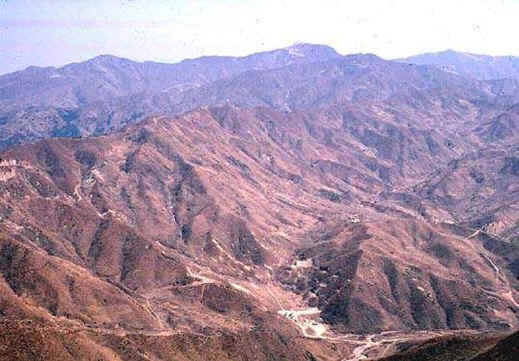 A
North Korean offensive across the DMZ would result in a World War I style slaughter
of North Korean infantry within a few miles of the border. The mobilized South Korean army is five times larger
than the mob of uniformed rice farmers just north of the DMZ. South
Korea would
easily win any war with
the North, which teeters on economic collapse during peacetime.
A
North Korean offensive across the DMZ would result in a World War I style slaughter
of North Korean infantry within a few miles of the border. The mobilized South Korean army is five times larger
than the mob of uniformed rice farmers just north of the DMZ. South
Korea would
easily win any war with
the North, which teeters on economic collapse during peacetime.
Not a single American soldier is needed to defend South Korea. The 8000 remaining American combat troops are just a symbolic commitment to South Korean security, and a diplomatic tool that deters South Korea from developing its own nuclear weaponry, which would upset China and Japan. The U.S. Army has yet to adjust to this reality. For example, it spends a billion dollars a year to maintain four American bases in southern South Korea - known as the Daegu complex. These logistics bases exist to support outdated plans to accommodate thousands of American troops arriving to help defend South Korea in wartime. No GIs are required to help the larger and vastly superior South Korean Army defend its nation from its poor northern cousins, and no one believes China would foolishly start a world war by attacking its major trading partner, South Korea.
American Hostages in South Korea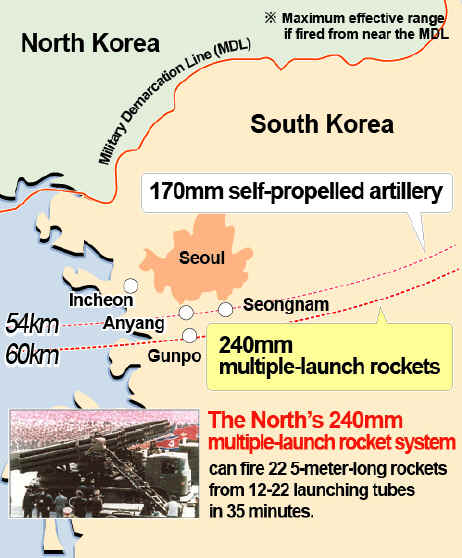
Despite North Korea's weakness, the threat of violent conflict remains. Deadly incidents occur every few years, like the minor hour-long artillery duel in 2010. North Korea has thousands of artillery guns that can quickly rain destruction across the DMZ. A minor incident may escalate into a massive artillery exchange within minutes, and kill tens of thousands of South Koreans within a day. Thousands of Americans would also die since they live concentrated at bases within range of North Korean artillery. After a bloody artillery exchange, North Korean leaders would quickly announce a unilateral cease fire, seeking to avoid a war that they would certainly lose.
This would place American leaders in a dilemma. South Korea would seek to avoid further devastation to its 11 million citizens in Seoul. South Koreans leaders would reject American demands for a massive bombing campaign, and American prestige would suffer greatly if North Korean fire focused on American bases along the DMZ, filled with evil imperialists who continue their colonial occupation of Korea. This description may seem outrageous to Americans, but not to Koreans, including many South Koreans. Millions of Koreans were killed during the Korean war as that nation became a Cold War battleground for the major powers. The remaining American bases are considered the major source of friction between the two Koreas, so their destruction would seem just to many Koreans.
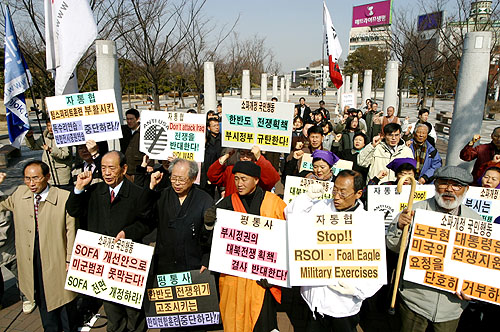 Most
South Koreans do not view Americans as saviors from communism. They have
no memory of the Korean war and want peace. A key step is the closure of American bases
because North Korea has long maintained that the withdrawal of all foreign
forces from the Korean peninsula is a prerequisite for peace. There are no
Chinese or Russian forces in North Korea, even though South Korea is far
stronger. South Korea political leaders deal with a growing number of
nationalists and pacifists who want the American military to leave, and
traditional supporters of a long standing alliance. Many South Koreans support American bases
only because they benefit from the billions of dollars in
annual American military spending, which generates tens of
thousands of jobs.
Most
South Koreans do not view Americans as saviors from communism. They have
no memory of the Korean war and want peace. A key step is the closure of American bases
because North Korea has long maintained that the withdrawal of all foreign
forces from the Korean peninsula is a prerequisite for peace. There are no
Chinese or Russian forces in North Korea, even though South Korea is far
stronger. South Korea political leaders deal with a growing number of
nationalists and pacifists who want the American military to leave, and
traditional supporters of a long standing alliance. Many South Koreans support American bases
only because they benefit from the billions of dollars in
annual American military spending, which generates tens of
thousands of jobs.
Attitudes would harden if thousands of South Koreans perish during a brief and senseless artillery exchange across the DMZ. Millions of South Koreans would blame the U.S. Army for instigating the incident, or escalating it, no matter the evidence. Violent protests may erupt outside U.S. military bases as thousands of angry South Koreans mass for revenge. American troops and their families may be forced to flee South Korea under armed escort by the South Korean Army as part of a humiliating retreat from South Korea. American Congressmen may also prompt a retreat, demanding to know why American troops live in such danger.
American troops may be expelled without a major incident since modern South Korea has become a world economic power with proud people who often fight with American servicemen on the streets of South Korea. These minor incidents may eventually ruin our alliance to the extent that South Korean leaders expel American forces from South Korea. This may also occur should tensions rise between China and Japan. Koreans have strong cultural and trading ties with China, still dislike Japan, and do not want their nation to become a battleground again. If war threatens between China and Japan or its close ally the USA, South Korea would probably declare neutrality. The South Korean Army would peacefully seize American bases and quickly expel American troops.
Rumsfeld's Solution
One reason former Defense Secretary Donald Rumsfeld was hated in the Pentagon is that he demanded change. He recognized that American troops were no longer needed to defend South Korea, and their presence was counterproductive since they provide North Korea with great propaganda and easy targets. In 2004, Rumsfeld implemented a long-term plan to reduce the American presence and withdraw American troops south of Seoul, thus out of range of North Korean guns, although still vulnerable to "SCUD" missiles.
 He forced
change by withdrawing one combat brigade
and closing some small bases, but only after agreeing to billions of dollars in new
spending to move the remaining troops south of Seoul. South Korea paid some of this cost, yet U.S. taxpayers have spent $13
billion to implement an expensive scheme called the "Land Partnership
Plan" (LPP). American troops will be withdrawn from dozens of smaller camps into six
large, modern bases. This plan has been delayed for years and is now
scheduled for completion in 2016.
He forced
change by withdrawing one combat brigade
and closing some small bases, but only after agreeing to billions of dollars in new
spending to move the remaining troops south of Seoul. South Korea paid some of this cost, yet U.S. taxpayers have spent $13
billion to implement an expensive scheme called the "Land Partnership
Plan" (LPP). American troops will be withdrawn from dozens of smaller camps into six
large, modern bases. This plan has been delayed for years and is now
scheduled for completion in 2016.
Generals Scheme to Kill the LPP
U.S. Army Generals dislike the LPP, so delays in its implementation are no surprise. North Korea provides a perpetual peacetime threat. If American troops withdraw from danger, American Generals will no longer be players if war erupts, and American troops may not even take part in fighting. American civilian leaders may finally cross off the threat of a North Korean invasion as a justification for a large peacetime army. Withdrawing American troops far from the DMZ may result in peaceful reunification, resulting in closure of all U.S. Army bases in Korea, and justify a further 50,000-man downsizing in U.S. Army active-duty force structure.
As a result, American Army Generals quietly sabotaged the LPP. The simplest part of the LPP was a transfer of wartime command responsibility from American Generals to South Korean Generals. This was supposed to happen in 2007, but was pushed forward to 2012, and postponed again until 2015. In 2012, American Army Generals demanded another delay, claiming that South Koreans Generals are still too immature to handle such responsibility.
Delaying the LPP agreement to withdraw American troops from bases near the DMZ is another tactic. While a few small U.S. Army bases have closed, three large bases near the DMZ remain full. Since the expansion of Camp Humphreys began in 2006 to accommodate all units north of Seoul, the only large camp starting to close is the highly visible 8th Army headquarters complex at Yongsan in Seoul. However, Army Generals want to keep a big base in Seoul to influence leaders. Soon after the LPP was signed, they began spending millions of dollars expanding a small former U.S. Air Force facility known as K-16, adjacent to the Seoul military airbase, to include a command post "Tango."
 The 2nd Battalion of the 2nd Aviation
Brigade did not withdraw to join its three other battalions at Camp
Humphreys. It flew to K-16 from closing Camp Stanley in 2005 with dozens of CH-60
helicopters to expand the base population above 1000 soldiers. New sports facilities were added at
growing K-16, including a new indoor swimming pool
(pictured) and a new commissary. None of this fits with
the LPP goal of saving money by
consolidating facilities at Camp Humphreys and removing American troops out of
North Korean artillery range, and out of sight from the millions in Seoul.
The 2nd Battalion of the 2nd Aviation
Brigade did not withdraw to join its three other battalions at Camp
Humphreys. It flew to K-16 from closing Camp Stanley in 2005 with dozens of CH-60
helicopters to expand the base population above 1000 soldiers. New sports facilities were added at
growing K-16, including a new indoor swimming pool
(pictured) and a new commissary. None of this fits with
the LPP goal of saving money by
consolidating facilities at Camp Humphreys and removing American troops out of
North Korean artillery range, and out of sight from the millions in Seoul.
New construction at "closing" Camp Casey provides further evidence of a plot to derail the LPP. It is one of three large bases near the DMZ yet to close. Millions of dollars were spent to build and open a new K-8 school at Camp Casey in 2010 (pictured). This is not a newer school that replaced an old one; the Army never had a school north of Seoul. Millions more dollars were spent to renovate the base chapel and swimming pool. When asked to comment on stories in the South Korean press that Camp Casey will remain open, the U.S. Army refused to refute them. American Generals even refused to comment on rumors that Camp Casey will remain when asked by the U.S. military's own newspaper, the "Stars and Stripes." Many local Koreans are upset since they have plans to use the base facilities, while others want foreign troops to leave and remove the threat of North Korean bombardment.
 As the U.S. Army withdrew from Iraq, the Korean press began
reporting a secret build-up of U.S. Army forces in Korea. The Pentagon denied
this, yet starting in 2009 it no longer reported its troop levels in South
Korea. Such data is posted online each quarter, which shows American troop strength in
every nation worldwide, including Iraq and Afghanistan, yet troop
levels in South Korea are "not available" and remain
secret. In 2012, an obscure Pentagon
report noted 37,354 U.S. troops stationed in South Korea as of Sept.
30, 2011; 8,854 more than the 28,500 agreed upon.
As the U.S. Army withdrew from Iraq, the Korean press began
reporting a secret build-up of U.S. Army forces in Korea. The Pentagon denied
this, yet starting in 2009 it no longer reported its troop levels in South
Korea. Such data is posted online each quarter, which shows American troop strength in
every nation worldwide, including Iraq and Afghanistan, yet troop
levels in South Korea are "not available" and remain
secret. In 2012, an obscure Pentagon
report noted 37,354 U.S. troops stationed in South Korea as of Sept.
30, 2011; 8,854 more than the 28,500 agreed upon.
In 2012, the Army urgently moved a 250-man chemical defense battalion to South Korea, but decided to base it at "closing" Camp Stanley instead of Camp Humphreys. If our forces are vulnerable to a chemical attack near the DMZ, the solution is not to deploy more troops into a kill zone, but accelerate plans to move them out, especially the military families. If North Korean chemical weapons pose a dire threat to our bases near the DMZ, our Generals should close the new school at Camp Casey and evacuate military dependents from South Korea. Yet our military plans to spend billions of dollars to double the number of American primary schools in South Korea and increase enrollment 355% for 18,000 additional American school children due to arrive as the American Army cements a perpetual city-state presence.
While Army
Generals continue to warn of dangers from North Korea, they don't explain the
logic to spending an additional billion dollars each year to maintain 18,000 more military
dependents in that potential war zone. Our Army and Air
Force conduct chemical defense drills at their bases as troops don protective
suits and gas masks. No one seems concerned about the unprotected American
civilians and school children living on these bases.
Our South Korean ally has agreed to pay for a huge military family housing project at Camp Humphreys. (pictured) It will make a perfect target for North Korean or Chinese tactical missiles should war occur, with an nice "bulls eye" circle! Our 8000 combat troops based there will not have time for combat as they remain home protecting their families while our Army's primary wartime mission becomes the evacuation of military families, which could be ugly if thousands are injured or victims of North Korean chemical weapons.
Spending a billion dollars a year to keep 18,000 more military families in a potential war zone is profitable for some "developers." The U.S. Congress GAO studied this plan in 2011, and learned the South Korean built family housing is not a gift from our ally. Page 15 of their report states:
 13.
According to USFK officials, the Humphreys Housing Opportunity Program would use
private developers to construct military-housing facilities at Camp Humphreys
that in turn would be rented by military service members using DOD overseas
housing allowance funds—estimated at $4,200 per month.
13.
According to USFK officials, the Humphreys Housing Opportunity Program would use
private developers to construct military-housing facilities at Camp Humphreys
that in turn would be rented by military service members using DOD overseas
housing allowance funds—estimated at $4,200 per month.
This means American taxpayers will pay South Korean "developers" $50,400 a year in rent for each family housing unit, which is more than each soldier's annual salary. These aren't even homes, but high rise condos. They are not located in expensive Seoul but a rural area. Since the average South Korean earns just $20,000 a year, they don't pay $50,400 a year in rent.
The Army's housing website for Camp Humphreys says that local rent is between $1000 to $1500 a month, not $4200. The Korean developers didn't even pay for the land and don't pay property taxes since their condos are on a U.S. military base! Why did our Generals agree to this? American families should remain safely in the USA as most soldiers continue unaccompanied tours. Korean developers can rent these condos to South Korean base workers, at local rates.
Deactivate the 8th Army Command
The U.S. Army in Korea remains on a spending spree, despite the need to reduce military spending to meet congressionally mandated cuts. Our Army in South Korea is not consolidating, but expanding. Camp Humphreys is the Army's largest construction project since the Panama Canal. The justification is that it removes American troops from easily targeted bases near the DMZ and cuts base operations costs by consolidating at Camp Humphreys. If our Generals derail the LPP to retain bases near the DMZ and at K-16 in Seoul, the expensive LPP effort fails. Once our Generals finally claim they lack the money to complete the LPP, civilian leaders must order a solution; disband 8th Army headquarters.
The U.S. Army maintains over 17,500 soldiers in South Korea yet only 8000 are combat troops. Since our Army must eliminate tens of thousands of positions over the next few years, an obvious target are the non-combat troops in South Korea along with thousands of civilian positions. The G2mil article: Cut Army Fat in Korea recommends closing the four outdated U.S. Army bases in southern South Korea and disbanding their resident 19th Sustainment Command. It also recommends eliminating 8th Army headquarters along with its 1st Signal Brigade, 501st Military Intelligence Brigade, and downsizing its 65th Medical Brigade to a hospital battalion.
These 8th Army elements are designed to command and support over 100,000 combat troops, but only 8000 remain in Korea organized into four brigades. The 2nd Infantry Division in Korea commands three brigades and can take charge of the 35th Air Defense Brigade at nearby Osan. Eliminating non-combat troops is important since the Army is downsizing as it shrinks the active-duty force from a post 9-11 wartime high of 570,000 to 490,000 by 2017.
In June 2013, Army Chief of Staff Gen. Ray Odierno said the Army will cut 10 brigade combat teams and reorganize the rest, which implies a serious cut. But the details show that only 10 brigade headquarters will be eliminated, while their subordinate units will be reassigned to increase the combat power of the remaining 33 brigades. Army Vice Chief of Staff Gen. John Campbell noted the cuts will result in the loss of only 17,700 positions. The recent inactivation of the two brigades and several smaller enabler units in Europe represent a reduction of another 11,700 slots.
General Campbell added: “The BCT [brigade] reduction is just one small part” of the 80,000-troop reduction in end strength. The 11,700 cut from Europe and 17,700 from 10 brigade headquarters total only 29,400 soldier slots out of 80,000 needed! Where is the serious plan to cut another 50,000 soldiers by 2017? Unless the Army closes bases or eliminates large headquarters, it will have to cut 11 full brigades. In 2018, Generals will have to explain why an Army with 490,000 active duty soldiers can only field 22 combat maneuver brigades totaling 88,000 soldiers.
Instead of cutting combat brigades, the Army could cut the equivalent of 20,000 positions (half civilian) by closing excess bases and excess headquarters in Germany. Eliminating outdated overhead in Korea (the 8th Army command and Daegu camps ) would allow another 8000 non-combat positions to be eliminated, along with some 6000 civilian positions. Cutting this fat would solve most of the Army's downsizing needs, and result in no economic losses to American communities.
Move Our Troops Out of Danger
Army Generals quietly insist that we must keep combat forces along the DMZ to show American resolve. They note that moving American artillery to Camp Humphreys will not allow them to quickly engage North Korean artillery should another sudden artillery exchange occur. It seems American artillerymen somehow participated in the 2010 shootout since one artillery brigade received an award.
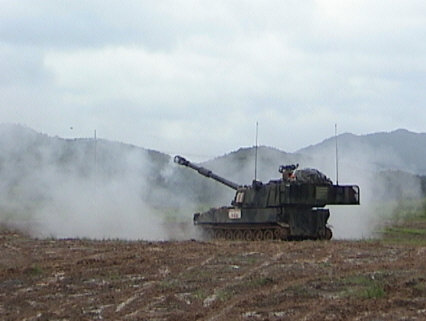 Yet this is
why American troops must quickly withdraw from the DMZ! A major artillery duel
may kill thousands of South Koreans. This would lead to serious political tensions. If American artillery units are
involved, North Korea would blame the Americans. Millions of South Koreans would be furious if thousands
of Koreans die from a pointless artillery exchange and many would direct their
anger toward Americans. Once the shooting stops, protests, riots,
and violence against Americans should be expected.
Yet this is
why American troops must quickly withdraw from the DMZ! A major artillery duel
may kill thousands of South Koreans. This would lead to serious political tensions. If American artillery units are
involved, North Korea would blame the Americans. Millions of South Koreans would be furious if thousands
of Koreans die from a pointless artillery exchange and many would direct their
anger toward Americans. Once the shooting stops, protests, riots,
and violence against Americans should be expected.
The facts about who fired first and why would be irrelevant because South Koreans would not know who to believe. However, if American artillery is stationed too far south (at Camp Humphreys) to participate in a sudden artillery exchange, Americans could not be blamed for killing Koreans. In addition, the USA would not face the embarrassing sight of thousands of Americans killed and wounded at DMZ bases, to include school children, while South Korea leaders announce a ceasefire agreement. Camp Humphreys and Osan airbase further south would be hit with some North Korean SCUD missiles, but many of those can be shot down with American Patriot air defense systems. Causalities would be low since the number of North Korean SCUDs are limited and their accuracy poor, although may be much higher if the mindless $22 billion plan to station another 10,000 American family members at Camp Humphreys proceeds.
If the withdrawal of the U.S. Army's 210th Fires (i.e. rocket artillery) Brigade and a battalion of American 155mm howitzers from the DMZ leaves a defensive gap, South Korea can easily fill it. It can reverse its decline in military spending to form artillery units at Camp Casey. Or, the U.S. Army can simply hand over their guns and missile launchers and go home! Since South Korean industry outperforms the United States in the production of sophisticated electronics (e.g. Samsung) South Koreans can certainly operate American artillery systems, which use Asian computer chips. If confusion, errors, and political games result in the death of thousands of Koreans from a massive artillery exchange, only Koreans can be blamed as Americans watch events from further south at Camp Humphreys.
Civilian Leadership is Essential
Army Generals claim that after two major extensions, the LPP is now on schedule to consolidate troops at Camp Humphreys by 2016. Yet a June 15, 2013 news report noted that construction is only 53% complete and details remain sketchy: "USFK has refused to release significant details about the pace of building and the scheduled movement of units to the base. However, USFK commander Gen. James Thurman told a community forum at U.S. Army Garrison Yongsan in Seoul earlier this year that some delays in the Humphreys move were possible, but in 2016, we’re going to be pretty much down there.'” If pressed by Congress, the General would probably admit that he was referring to the Yongsan base, not American troops at bases near the DMZ.
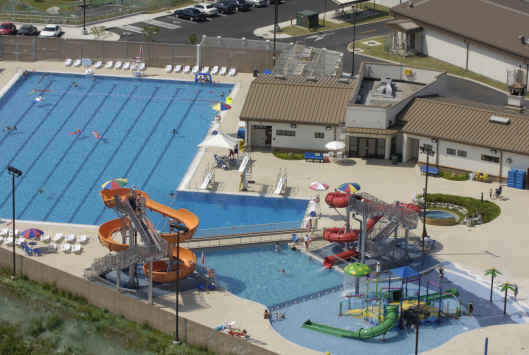 LPP
construction priorities prove that Army Generals were never serious about
withdrawing combat forces to Camp Humphreys. One of the first LPP projects to be
completed there was a water park in 2007. (pictured) As Army Generals warned of rising costs in South Korea due to LPP delays, Congress was irritated
to learn that the Army was constructing a $10.4 million museum. Meanwhile,
ground breaking for the a massive $324 million 8th Army headquarters complex at Camp
Humphreys didn't occur
until July 2013!
LPP
construction priorities prove that Army Generals were never serious about
withdrawing combat forces to Camp Humphreys. One of the first LPP projects to be
completed there was a water park in 2007. (pictured) As Army Generals warned of rising costs in South Korea due to LPP delays, Congress was irritated
to learn that the Army was constructing a $10.4 million museum. Meanwhile,
ground breaking for the a massive $324 million 8th Army headquarters complex at Camp
Humphreys didn't occur
until July 2013!
It will surprise no one if Army Generals tell Congress in 2016 that they need billions more dollars to finish facilities for combat units, or they will be "forced" to keep three bases open near the DMZ. Army Generals used this strategy to delay the drawdown in Germany ordered by the Bush administration, which wasted billions of dollars. For example, the Army closed modern facilities in Germany and built an entirely new base in Italy that opened in July 2013. Congress must order a GAO investigation and have key Generals appear in 2014 to present a detailed plan of the final phase of the LPP scheme showing that it will completed on time and on budget, so all American troops will be withdrawn south of Seoul by the end of 2016.
Current news reports indicate that Army Generals would dance around details and use the occasion to argue the need to keep bases near the DMZ open. After documenting the failure of Army Generals to implement the LPP, civilian leaders must explain that the LPP must be completed as soon as possible to remove American troops from danger and the USA from a possible diplomatic nightmare. Civilian leaders must order the 8th Army headquarters and its supporting brigades disbanded in 2015 as South Korea assumes wartime control of its military forces. American leaders must order K-16 closed and the four camps of near Daegu. This will ensure the withdrawal all American soldiers outside North Korean artillery range, complete the LPP on time and below budget, ease tensions in Korea, save billions of taxpayer dollars, and free thousands of American soldiers for combat duty worldwide.
Carlton Meyer editorG2mil@Gmail.com
©2013 www.G2mil.com
Dec 2014 Update - Army General Rips Up Orders
A U.S. Army General formally announced that he will not abide by a treaty signed by American and South Korean leaders in 2004. He will keep forces near the DMZ to help justify the Army's budget and force structure, even though they are not needed and not desired by local South Koreans. Army Generals have planned this power play for years.
Jan 2014 Update - Games Generals Play
The U.S. Army increased combat forces in South Korea by moving an armored battalion from Texas to camps near the DMZ that are suppose to close this year. All this extra spending is at a time when Army Chief of Staff General Ray Odierno is telling Congress that his army is devastated by budget limits and only two brigades are combat ready.
Mar 2014 Update - South Korea Slashes Military Manpower
Despite constant media stories about the North Korean threat, South Korea will cut its active duty military from 640,000 to 522,000 by 2022, citing the country’s declining birth rate as the reason for the downsizing. According the CIA Factbook, South Korea has almost 11 million men fit for military duty, so the "declining birthrate" excuse to downsize and cut costs is absurd. South Korea spends roughly half as much of its GDP on national defense compared to the USA and its economy continues rapid growth as it surpasses the USA in many areas of technology -- ever hear of Samsung? Most Americans would be outraged by these facts, which is why they never appear in our major corporate media.
Sep 2014 Update - U.S. Army Generals Demand that American Artillery Remain
As predicted, U.S. Army Generals demand to stay near the DMZ, even as the South Koreans repeatedly refuse.
Jul 2020 - Tales of the American Empire
Mini-documentary - The Mythical North Korean Threat
